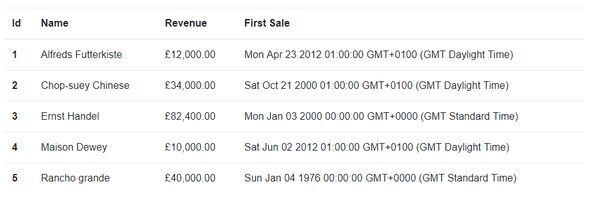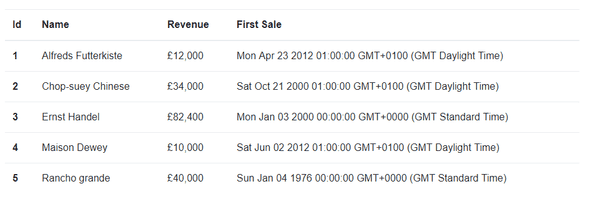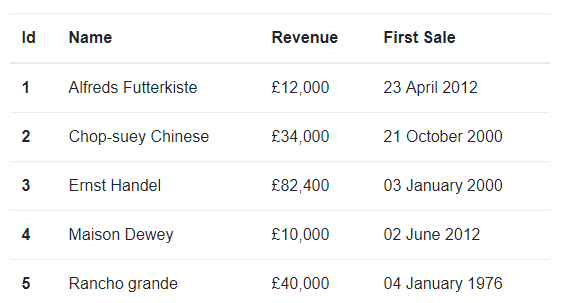Formatting dates and numbers in React
Formatting numbers and dates is a common requirement for lots of apps but how do we do this in react apps?
Let’s say we have a component in our app that shows a list of customers, looking like this:
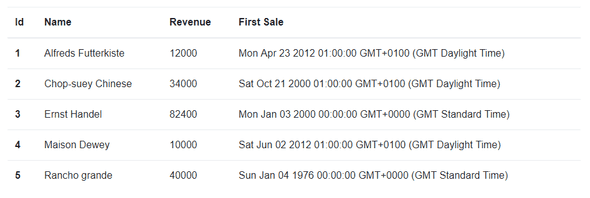
… and here’s the current code for this component:`// CustomerSearchResults.tsx
// CustomerSearchResults.tsx
import * as React from "react";
import Customer from "./Customer";
interface CustomerSearchResultsProps {
customers: Customer[];
}
const CustomerSearchResults = (props: CustomerSearchResultsProps) => {
const rows = props.customers.map(customer => (
<tr key={customer.id}>
<th>{customer.id}</th>
<td>{customer.name}</td>
<td>{customer.revenue}</td>
<td>{customer.firstSale.toString()}</td>
</tr>
));
return (
<table className="table table-hover">
<thead>
<tr>
<th>Id</th>
<th>Name</th>
<th>Revenue</th>
<th>First Sale</th>
</tr>
</thead>
<tbody>{rows}</tbody>
</table>
);
};
export default CustomerSearchResults;… with the following data:`// customers.json
// customers.json
[
{
id: 1,
name: "Alfreds Futterkiste",
revenue: 12000,
firstSale: "2012-04-23T00:00:00.000Z"
},
{
id: 2,
name: "Chop-suey Chinese",
revenue: 34000,
firstSale: "2000-10-21T00:00:00.000Z"
},
{
id: 3,
name: "Ernst Handel",
revenue: 82400,
firstSale: "2000-01-03T00:00:00.000Z"
},
{
id: 4,
name: "Maison Dewey",
revenue: 10000,
firstSale: "2012-06-02T00:00:00.000Z"
},
{
id: 5,
name: "Rancho grande",
revenue: 40000,
firstSale: "1976-01-04T00:00:00.000Z"
}
];You can see that we need to clean up the revenue and first sale data by formatting them.
Formatting numbers
We can use Intl.NumberFormat to format the revenue:
<td>
{new Intl.NumberFormat("en-GB", {
style: "currency",
currency: "GBP"
}).format(customer.revenue)}
</td>In the above example we are formatting to revenue using Great British locale, using the Great British currency style.
But what if we don’t want the decimals in the revenue? We just add the min and max fraction digits in the options:
<td>
{new Intl.NumberFormat("en-GB", {
style: "currency",
currency: "GBP",
minimumFractionDigits: 0,
maximumFractionDigits: 0
}).format(customer.revenue)}
</td>Formatting dates
We could just use toLocaleDateString instead of toString:
<td>{customer.firstSale.toLocaleDateString()}</td>… which gives us a nice short date:
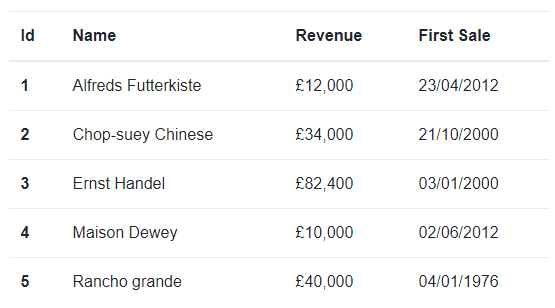
However, we can use Intl.DateTimeFormat to gain more control on the formatting:
<td>
{new Intl.DateTimeFormat("en-GB", {
year: "numeric",
month: "long",
day: "2-digit"
}).format(customer.firstSale)}
</td>Here we are specifying a 2 digit day, a long month and a 4 digit year.
So, here’s our final CustomerSearchResults component code:
// CustomerSearchResults.tsx
import * as React from "react";
import Customer from "./Customer";
interface CustomerSearchResultsProps {
customers: Customer[];
}
const CustomerSearchResults = (props: CustomerSearchResultsProps) => {
const rows = props.customers.map(customer => (
<tr key={customer.id}>
<th>{customer.id}</th>
<td>{customer.name}</td>
<td>
{new Intl.NumberFormat("en-GB", {
style: "currency",
currency: "GBP",
minimumFractionDigits: 0,
maximumFractionDigits: 0
}).format(customer.revenue)}
</td>
<td>
{new Intl.DateTimeFormat("en-GB", {
year: "numeric",
month: "long",
day: "2-digit"
}).format(customer.firstSale)}
</td>
</tr>
));
return (
<table className="table table-hover">
<thead>
<tr>
<th>Id</th>
<th>Name</th>
<th>Revenue</th>
<th>First Sale</th>
</tr>
</thead>
<tbody>{rows}</tbody>
</table>
);
};
export default CustomerSearchResults;… and here’s what it looks like:
Much better!
Did you find this post useful?
Let me know by sharing it on Twitter.If you to learn about using TypeScript with React, you may find my course useful:

